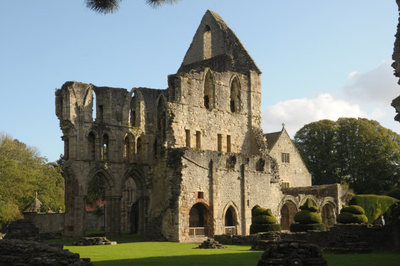Origins of the Much Wenlock Name
Published 26 April, 2011There are two popular versions that we will offer to you and you can choose the one that you think fits!
Version One
Our first reference comes from The Place-Names of Shropshire: (Dr. Margaret Gelling and H.D. Foxall.1990).
MUCH comes from the Middle English (1150-1500) word meaning ‘muchel’ ‘mochel’ meaning great.
WEN is from the Welsh ‘gwyn’ meaning white, (the feminine form of gwyn is “gwen”).
LOCK maybe from the Old Welsh “loc” meaning monastery or from the English ‘loca’ meaning enclosed place. Both words are derived from the Latin “locus” meaning place.
When St. Milburga came here, the name of this place, according to the Foundation Charter of the Abbey dated around 685 A.D., was WINNICAS.
WIN from the Welsh ‘gwyn’. Place name specialists have been unable to offer an explanation for the remainder of the name.
It has been suggested that behind the name ‘WENLOCK’ there may be a pre-English district name meaning something like, “White area”-possibly from the limestone of Wenlock Edge.
Welsh was the language of this area until the Mercians came and would have been spoken for a considerable time afterwards.
The Domesday Book (1086) listed it as Wenloch.
Magna Wenlak was recorded in 1291.
From about 1550 Much (moche) Wenloc appears to have been in common use with varying spellings of Wenlock.
Version Two
We have given you the above version first, because it seems to be the most popular amongst the locals of Wenlock, however, another version has been suggested by researchers:
MUCH. A comparatively late addition to the name. Earlier documents give it as Great or Magna. This affix serves to distinguish it from Little Wenlock, its possession on its northern border and also to indicate Much Wenlock’s importance as the largest of England’s Shire boroughs until the boundary changes in the 1970's.
WENLOCK. The earliest spellings we have for the name are from the 9th Century where we find it as Wynlocan and Wenlocan. (F. Liebermann. Die Heiligen Englands). Shropshire was in Roman-British times the Area of the Cornovii (Kenewek), who gave their name to the Cornish language which they spoke.
WEN is an Anglian version of the Cornish name Owen, itself a shortened version of the Cornish name Aldowen. The name means, in Cornish, “born in the lower land”. Wenlock’s Owen is probably from the land of Dobuni. The “people of the lower land” of what is now Gloucestershire and South Herefordshire. He may have given his name to Trefowen and St. Owen’s Cross in Herefordshire.
Lock, lach, locan and other spellings derive from the Cornish word loch, which is always a water feature of some kind, either a pool, especially a marine pool, or a river, especially an underground river. The English word lake, in the old sense of “river”, derives from the Cornish word. Much Wenlock has many underground streams, but it is probably the stream from which our St. Owen’s Well in Back Lane drew it water that is here indicated.
Wenlock thus means ”Owen’s stream” or, in the 9th Century spelling, which is a diminutive, “Owen’s little stream”. Since the well derives from the stream, one may also translate the name as “Owen’s Well”.
St Milburga calls the area, not the town, in which she has her Abbey Wininicas. This region, of 24 square miles in extent, means “region of the followers of Owen”. (Cf. E.W. Bocock, The Placenames of Shropshire).






